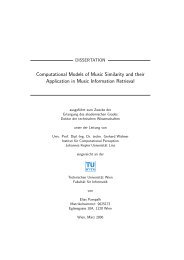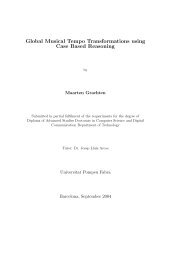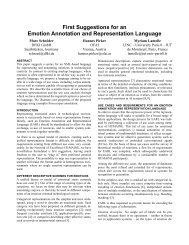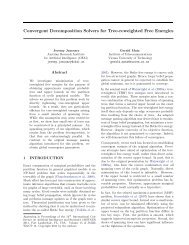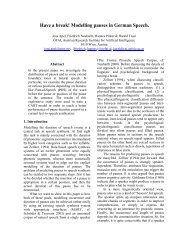A HYBRID MODEL OF REASONING BY ANALOGY
A HYBRID MODEL OF REASONING BY ANALOGY
A HYBRID MODEL OF REASONING BY ANALOGY
Create successful ePaper yourself
Turn your PDF publications into a flip-book with our unique Google optimized e-Paper software.
Evaluation can be started after the transfer of new knowledge is finished, but it is also possible to<br />
evaluate each single transfer (before the transfer process proceeds). As Keane (1988) points out,<br />
usually in a familiar target domain the evaluation is done during transfer, while in unfamiliar<br />
domains often a hypothesis needs to be tested in the real world after the transfer is complete.<br />
Learning is running in parallel to all other processes, enabling the storing of maps, analogical<br />
inferences, evaluations or failures, and all other kinds of intermediate results. It can, however, start<br />
after the problem is solved as well, in order to store the target description together with the<br />
solution, possibly to make some generalizations and store them, and to adjust link weights in order<br />
to provide for better retrieval in the future.<br />
All triggering of these symbolic processes as well as their termination and speed are controlled by<br />
the associative mechanism, i.e. by pragmatic factors.<br />
6. A COMPUTER SIMULATION<br />
A computer implementation of AMBR has been developed that simulates human problem solving<br />
in the area of cooking and boiling water, eggs, etc. in the kitchen or in the forest. The simulation<br />
system demonstrates AMBR's capability of analogical problem solving as well as some of the<br />
priming effects found in the experiments described in section 2.<br />
The Simulation Program has been developed in Common Lisp on an AT/286-type computer with 6<br />
MB of RAM.<br />
6.1. The Knowledge Base of the Simulation and the Target Problem<br />
The knowledge base of the simulation program contains about 300 nodes and 4,000 links. There<br />
are about 10 situations related to water, three of which are the following: A) heating water on the<br />
plate of a cooking-stove in a pot (figure 11a), B) on the fire in a wooden vessel (figure 11b), and<br />
C) heating water by means of an immersion heater in a glass (figure 11c).<br />
><br />
A simplified formulation of the target problem given in the psychological experiments is used as a<br />
test example in the simulation: how can you heat water in a wooden vessel when you<br />
are in a forest, having only a knife, a match-box and an axe. The problem is<br />
represented in the following way: the reasoner should look for a situation in which the water is in a<br />
wooden vessel and which will cause another situation in which the water will be hot and will still<br />
be in the wooden vessel (figure 12).<br />
><br />
The links between the nodes corresponding to these situations (e.g. G1) and the nodes<br />
corresponding to all concepts referred to in these descriptions (G101, G102, etc.) are weighted<br />
(the weights are not shown on the figure for simplicity). There are also weighted a-links in the<br />
reverse direction (e.g. from water to G101, and from G101 to G1). The weight of a link depends<br />
on the typicalness of the corresponding relation, i.e. how often it is used. For example, the<br />
weights of the links between water and heat on the one hand and situation A on the other hand are<br />
greater then that connecting water and heat with situations B and C, because A is a more typical<br />
situation then B and C.




